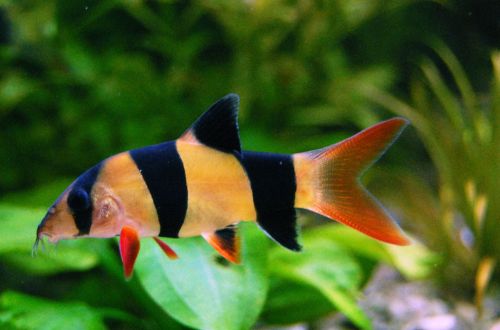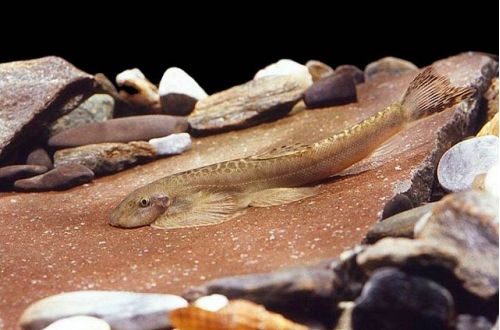
Bocilia clown
Botia clown or Bocilia clown, scientific name Chromobotia macracanthus, belongs to the Cobitidae family. This type of loach is often touted as an easy to care for and friendly fish. In reality, everything is not so clear. Firstly, the fish can grow to large sizes (30 cm or more), although this does not happen often in home aquariums. It has a significant life expectancy – up to 20 years, during which it continues to grow. And most importantly, the Clown Botsia poses a threat to smaller fish, so the selection of neighbors should be treated very carefully.

Contents
Habitat
It comes from Southeast Asia from the islands of Borneo (Kalimantan) and Sumatra. They live in the main channels of rivers flowing among tropical rainforests. During the rainy season, they migrate upstream for spawning and into smaller tributaries. Depending on the time of year, water parameters change (temperature, turbidity, pH and dGH parameters). The habitat is characterized by dense vegetation, roots and branches of trees submerged in water, and numerous snags. The bottom of the rivers is covered with fallen leaves.
Brief information:
- The volume of the aquarium – from 350 liters.
- Temperature – 24-30°C
- Value pH — 5.0–7.0
- Water hardness – soft (2-12 dGH)
- Substrate type – any
- Lighting – subdued
- Brackish water – no
- Water Movement – Moderate/Low
- The size of the fish is up to 30 cm.
- Nutrition – any drowning
- Temperament – inhospitable
- Content in a group of at least 5 individuals
Description
In the aquarium, adults reach a length of 15–20 cm, although specimens under 40 cm are not rare in nature. Sexual dimorphism is weakly expressed. Males are slightly smaller than females, but it is almost impossible to determine the sex in a group of different ages. Body coloration consists of alternating wide vertical stripes of black and orange. Near the mouth are sensitive antennae, with the help of which the fish finds food in the substrate layer.
Food
It feeds near the bottom, so it is necessary to use sinking food. The diet can consist of dry flakes, granules, frozen bloodworms, brine shrimp, as well as pieces of earthworm, shellfish. Be sure to add herbal supplements, otherwise the fish will damage the soft-leaved plants.
Maintenance and care, arrangement of the aquarium
The recommended aquarium size for a small group of Clown Bocilia starts at 350–400 liters. Decoration is optional, provided that the following conditions are met: soft sandy substrate and the presence of shelters of a suitable size. The most natural appearance is achieved in low light, using smooth stones, small boulders, snags (natural or artificial), thickets of shade-loving plants, Indian almond leaves as decor.
Maintaining high water quality is essential for keeping fish. To do this, in addition to installing a productive filtration system, it is necessary to replace part of the water (15–20% of the volume) with fresh water weekly and regularly remove organic waste, such as excrement, food debris, rotting leaves and plant roots.
Behavior and Compatibility
When kept alone, it becomes aggressive, it is necessary to acquire a group of 5 or more individuals. Rejection also manifests itself in relation to smaller fish. The clown boat is prone to biting off the long fins of its neighbors in the aquarium. Compatible with calm species of similar size found in the water column or near the surface.
Breeding / breeding
In nature, the mating season begins with the advent of the rainy season. Fish rush upstream and into the adjacent flooded areas, where spawning takes place. Eggs are released into open water and drift freely until they cling to aquatic vegetation, among which the newly born fry find shelter and food sources. As they mature, juveniles of Bocilia clownfish move downstream.
Changing environmental conditions and subsequent migration made it impossible to breed this species of loaches in home aquaria. Fish for sale come from commercial fish farms, where spawning is initiated artificially with the help of hormonal injections, or from the wild. On the islands of Borneo and Sumatra, such a type of fishing is common among local residents as the collection of eggs of Botsia-clown for sale.
Fish diseases
Health problems arise only in case of injuries or when kept in unsuitable conditions, which depresses the immune system and, as a result, provokes the occurrence of any disease. In the event of the appearance of the first symptoms, first of all, it is necessary to check the water for the excess of certain indicators or the presence of dangerous concentrations of toxic substances (nitrites, nitrates, ammonium, etc.). If deviations are found, bring all values back to normal and only then proceed with treatment. Read more about symptoms and treatments in the Aquarium Fish Diseases section.





